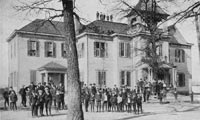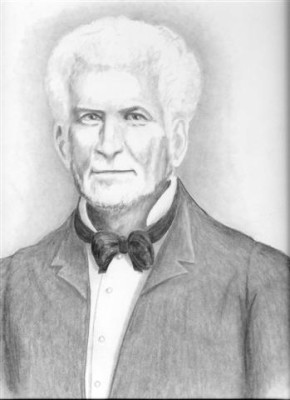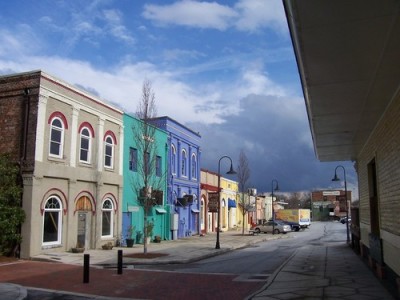 History of Conyers
History of Conyers
The history of Conyers and Rockdale County is diverse and dates back over ten thousand years. Early natives known as “The Mound Builders” were one of many groups who visited Rockdale’s gentle hills, lakes and streams. Much later, the Creek and Cherokee Nations shared a common border, the “Great Indian Road,” now known as Hightower Trail in northern Rockdale. In the early 1800s, this trail was a main route for white settlers moving inland after the American Revolution.
Georgia stretched all the way to the Mississippi River, and this Indian Road provided an irresistible magnet for European immigration. State authorities officially opened up what is now Rockdale County to settlers in 1816 and 1821. One of several settlements grew up around Costley’s Mill on Big Haynes Creek. This settlement grew to include the first school, a gristmill, a sawmill, a planing mill, and eventually a cotton gin. The area’s Salem Baptist Church still performs baptisms in the sparkling waters of the old millpond. A dozen or more mills appeared quickly including the three-story Kennedy-Baker Mill which used French burrs for grinding corn and wheat, but several were eventually burned down by Indians.
The earliest settlement occurred in the extreme northern edge of the county. The southern end of the county was settled as Scots and Scotch-Irish began moving up along the rivers and streams from what is now Henry County. These early families founded numerous churches including Smyrna Presbyterian in 1827, the oldest Calvinist Campground in the United States.
 The first known settler of Conyers was blacksmith John Holcomb, who built a log cabin where the County Courthouse now stands on Main Street. Holcomb protested against the coming of the railroad, but eventually sold his land for $700 to Dr. W.D. Conyers (pictured at left), a banker from nearby Covington. Dr. Conyers deeded right-of-way to the railroad and the village of Conyers Station was born.
The first known settler of Conyers was blacksmith John Holcomb, who built a log cabin where the County Courthouse now stands on Main Street. Holcomb protested against the coming of the railroad, but eventually sold his land for $700 to Dr. W.D. Conyers (pictured at left), a banker from nearby Covington. Dr. Conyers deeded right-of-way to the railroad and the village of Conyers Station was born.
By 1845, trains were running regularly between Marthasville (now Atlanta) and Augusta. In 1854, the village had grown to 400 residents and was incorporated as a town called “Conyers.”
The City has been destroyed at least partially by fire three times. However, during General Sherman’s March to the Sea in November 1864, at least one mill was left standing thanks to the cunning of its owner Aunt Winnie Pucket. Before the Union soldiers arrived at Costley’s Mill, Aunt Winnie sacked all the flour and hid the sacks in the millpond. The wet flour caked and protected the rest. Miraculously, Aunt Winnie’s pleas and threats convinced the soldiers to leave her mill alone.
In 1870, the Georgia legislature acknowledged Rockdale as a county. The name reflects the underlying granite strata that runs beneath the surface of the land, creating rocky hills and dales.
During that decade, Conyers quickly grew to 1,800 and boasted 12 saloons and five brothels. This wild town also had 40 stores, a fine hotel, good schools, one college, 12 lawyers and just as many doctors, and a large carriage manufacturer. One Conyers resident, Sally Fanny Gleaton, emerged as a leading suffragette during the progressive period following Reconstruction. She was well-educated and traveled extensively throughout Europe and North America, working with Carrie Chapman Catts, Eleanor Raoul and “Kit” Hepburn (Kathryn Hepburn’s mother) to see the 19th Amendment to the Constitution become law.
 Conyers was home to the prosperous mill community known as Milstead. The Village of Milstead, located two miles north of Olde Town Conyers, was once home to Milstead Manufacturing Company, later known as Callaway Mills. In its day it was a bustling, closely-knit, industrial town located on the banks of the Yellow River. The mill employed some 700 workers and also provided exceptional amenities to its workers that included housing, churches, a public school, post office, hotel, railroad, company store, drug store and recreational facilities that featured a golf course and swimming pool. In 1960, Callaway Mills closed the Milstead operation, however the churches and bungalow-type houses of the village still stand today and are home to many residents who continue to enjoy this unique and historic area of Conyers.
Conyers was home to the prosperous mill community known as Milstead. The Village of Milstead, located two miles north of Olde Town Conyers, was once home to Milstead Manufacturing Company, later known as Callaway Mills. In its day it was a bustling, closely-knit, industrial town located on the banks of the Yellow River. The mill employed some 700 workers and also provided exceptional amenities to its workers that included housing, churches, a public school, post office, hotel, railroad, company store, drug store and recreational facilities that featured a golf course and swimming pool. In 1960, Callaway Mills closed the Milstead operation, however the churches and bungalow-type houses of the village still stand today and are home to many residents who continue to enjoy this unique and historic area of Conyers.
Like many Georgia towns, Conyers takes pride in its “sidewalk churches.” Along Main Street today, Presbyterian and Methodist churches stand side-by-side. In 1878, First United Methodist began a legacy of joint action in a joint revival with its Presbyterian neighbors. The revival resulted in more than 100 new members and the closing of nine saloons in Conyers. These churches continue to have joint services throughout the year.
In 1944, a group of 20 Cistercian monks, or “Trappists,” from Kentucky arrived at the Depot to begin their monastic life in Georgia. On 2,000 acres that had once been a plantation, these men shared a massive, whitewashed, red brick barn with their herd of Jersey cows. By the end of that year, they had built a pine board monastery with asbestos shingles. They called this structure home for the next 16 years.
The building of a permanent monastery was postponed after the death of the founder, Dom Frederic Dunne, who had funded construction. Many citizens of Rockdale County — most of them Protestant — joined communities across the nation in helping the Trappists finish The Monastery of The Holy Spirit. It stands today southeast of Conyers off Georgia Highway 212. The Monks’ living quarters remain private. A public mass is held daily in the Abbey Church, which welcomes visitors, school children and retreat participants. To learn more about the Monastery of the Holy Spirit, visit their website: www.trappist.net.
With the construction of Interstate 20 through Rockdale County in the 1960s, the community began to change again. Olde Town Conyers gave way slowly to development along West Avenue and the I-20 access roads, then south along Georgia Highway 20/138, creating a business district of bright signs and national chains. The original commercial center of Conyers is now Olde Town Conyers, populated by attorneys and specialty shops.
During the 60s, the team of Gus Barksdale and Clarence Vaughn joined other influential citizens and the Chamber of Commerce in bringing numerous major businesses to Rockdale County. Meanwhile, James Miller, Jr. took over as Chairman of the County School Board and supported by fellow progressives Roland Reagan and Harry Downs, they made the system a model for the entire state in peaceful integration and academic excellence.
With new schools and the highest paid teachers in the area, Conyers and Rockdale County became a draw for young families. With industrial development booming, residential taxes remained low. Access to Atlanta became quick and easy, and Rockdale residents seemed upbeat and positive. Native sons and daughters followed Sally Gleaton in gaining national recognition; the list includes country singer Brenda Lee, Academy Award-winning actress Holly Hunter, Federal Budget Director James Miller and many others.
 Since Conyers developed as a train station, the Depot remains in Olde Town as the most historic site. It is used for meetings, weddings and other special events. In 2005, the Depot became the home of the Conyers Welcome Center. The Rockdale Historical Society maintains this facility, along with the Old Jail, and the “Dinky,” a 1905 Rogers steam locomotive that transported thousands of cotton bales and bleached cotton duct to and from nearby Milstead. The Dinky is one of only three such locomotives of its type in the world. It is permanently parked on the siderails across from the Depot, between Green and Railroad Streets.
Since Conyers developed as a train station, the Depot remains in Olde Town as the most historic site. It is used for meetings, weddings and other special events. In 2005, the Depot became the home of the Conyers Welcome Center. The Rockdale Historical Society maintains this facility, along with the Old Jail, and the “Dinky,” a 1905 Rogers steam locomotive that transported thousands of cotton bales and bleached cotton duct to and from nearby Milstead. The Dinky is one of only three such locomotives of its type in the world. It is permanently parked on the siderails across from the Depot, between Green and Railroad Streets.
Olde Town features lovely streetscapes, a pavilion, a botanical garden and stream. Many homes and buildings in Olde Town are listed on the National Register of Historic Places.
The summer of 1996 was an exciting time in Conyers-Rockdale County’s history. Over 600,000 visitors visited the community during the period of the Centennial Olympic Games. Visitors thrilled to equestrian events, first-ever mountain bike competition and the final two events of the modern pentathlon at Conyers’ Olympic venue, the Georgia International Horse Park. The Olympics put Conyers and Rockdale County not only on the map but in the minds of thousands that soon began relocating their homes, families and businesses to the area.
Conyers has now grown to 15,000 residents and Rockdale County to over 80,000. It is a combination of small town and big city, of rural scenes and urban shopping. The population now reflects many nationalities, races and religions. Most of all, the community reflects an amazing legacy of progress, involvement and society where everyone has contributed and everyone feels a sense of belonging.
 10 Free Things To Do in Conyers
10 Free Things To Do in Conyers
1. Make your first stop the Conyers Welcome Center and explore the historic Olde Conyers Depot (1891).
2. Imagine riding the rails on the Milstead 104 “Dinky” Steam Locomotive, a 1905 Rogers steam locomotive in Olde Town Conyers (pictured).
3. Wander the Lewis Vaughn Botanical Garden in Olde Town and view plants and flowers of the Georgia Piedmont region.
4. Discover the Old Jail Museum (1897) and its “hanging room.” The Rockdale County Historical Society offers free tours of the jail the second Saturday of each month from 10 a.m.-2 p.m. (pictured).
5. Enjoy the 1,400 acres Georgia International Horse Park, a legacy of the 1996 Centennial Olympic Games, now offering year-round events. Many events are free to the public!
6. Wander the Big Haynes Creek Nature Center trails at the Georgia International Horse Park.
7. Seek the peaceful serenity of the Rockdale County Master Gardener’s Memorial Arboretum, located at the Georgia International Horse Park.
8. Renew your spirit with a stop at Georgia’s only Monastery of the Holy Spirit, home to Cistercian monks for over 65 years, and admire the beauty of Bonsai specimens.
9. Walk with heroes at the Georgia Veterans War Memorial/Walk of Heroes remembering the sacrifices made during the twentieth century by veterans on a battlefield and by their families on the home front.
10. Visit Haralson Mill Covered Bridge, one of fifteen covered bridges in Georgia.


You must be logged in to post a comment Login